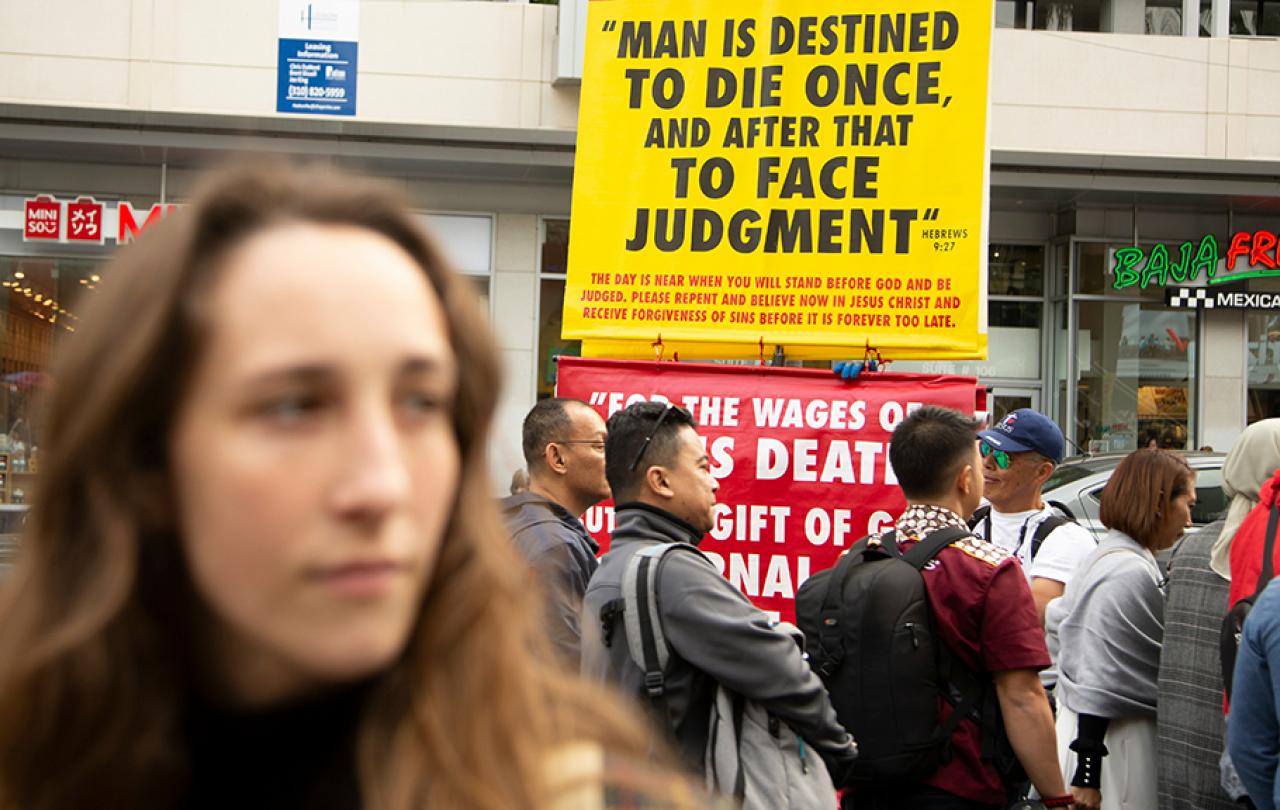
A few months ago, my cousin was visiting my hometown of Seattle for work. We planned to meet one evening for a Mariners baseball game during her visit. I suggested that we meet near the wonderful Ken Griffey Jr. statue near the stadium gates. What I hadn’t realized was that this was the precise spot a street evangelist had also decided to station himself in order to share (mostly shout) his message of judgement and destruction the same evening. Kind of like a pre-game verbal hors d'oeuvres. I arrived at the meeting point a few minutes before my cousin, giving me ample time to hear the preacher preach.
Now, I grew up in church, and, in fact, am myself a speaker and writer on topics involving faith and God. In other words, I’ve had over 40 years to experience the church’s, umm, “quirks”. I’d like to think that very little coming from the mouths of faith preachers could shock me. Alas, I was wrong.
As I began to listen to the preacher, lines like “weeping and gnashing of teeth” scorched through the preacher’s megaphone. Yep, nothing new there. The preacher used the word “judgment” a lot. Actually, impressively a lot. I’ve never before heard the words “God” and “judgment” used in conjunction more times within a two-minute span. There was a raging intensity to the sermon, but still in the range of normal for street preaching.
Then, my cousin texted me that she was outside the ballpark but might have gotten the location wrong. I realized she and I were at two different locations. While I texted my cousin back, I tuned out the preacher’s message. That is until I heard him shout through his megaphone, “He hates you.” I stopped texting. I looked up at the preacher. Did he just say that God the Almighty hated all of us outside the ballpark? Families, little boys and girls, and elderly? Did God hate all of us lining up for the game? It was “bark at the park” night so even the dogs were casualties in the preacher’s line of fire. If nothing else was gleaned from the man’s message, it seemed, we were all to understand that God hates us.
Minutes later, when my cousin and I finally found each other, I told her that she had had the good fortune of missing out on the street preacher informing her that God hates her. She replied, “Oh, I have plenty of others who tell me that!”
Sadly, many of us have received that negative message from different sources in our world and too often from people sharing some association with God.
In America, as election season comes to the boil, I’ve noticed (and maybe you have too) the not-so-subtle attitude that it’s okay to say mean things about another person as long as that person is on “the other side”. A verbal dig here, an eyeroll there, name-calling and slanderous nick-naming the enemy for the sake of ridicule have become all too common, if not a soft virtue in political discourse. It has become hard to discern where the moral line is, or if such a thing still exists within political dialogue.
Conversations like the following happen so frequently following a political debate or interview, they’ve become cliché: “I almost cannot believe he said that!” Response: “Well, yes, that was pretty bad. But he’s right, isn’t he?” Translation: it’s okay to be mean as long as you are mean and right.
Evangelicalism has gained a hard edge with little resemblance of the good news from which it has its very name.
The meaning of the word ‘evangelical’ here in America is a complex thing, to be sure. But perhaps one of the reasons it is understood as a political word more than a religious one is because the combative and rude nature of discourse seen in politics has become increasingly acceptable even in Christian settings. As a friend of mine said to me years ago, “It feels as though Christians have turned rudeness into a spiritual gift.”
The thing is, you probably don’t know the preacher I heard in downtown Seattle, but you’ve probably heard or know a person who makes Christian claims in the same kind of rude ways. The result is that evangelicalism has gained a hard edge with little resemblance of the good news from which it has its very name.
I’ve had the privilege of speaking to audiences on topics of faith and God for around 20 years now and I’ve lost count of the number of people I’ve met who feel unlovable, already hated, and unforgivable for the decisions they’ve made in life.
So when I hear a preacher shouting a message through a bullhorn in the name of God and I hear not words of hope, peace, grace, love, and forgiveness, but strictly judgement and burning, I fail to see how this God can be the one who came to earth out of love for people in the person of Jesus Christ.
It’s true that the Bible does depict God enacting justice and judgement. But equally true is that the Bible not only displays, but out-and-out defines God as being love. My concern with the street preacher’s message is that although he might have communicated the justice of God (albeit in a warped way that would make old-time revivalists look tame), his message left little room for hearing about and feeling the love of God.
If there is anything we need to hear today, it is the message that God, in his very nature, is love. One particular writer of antiquity, and a close friend of Jesus Christ, once penned a letter to first century churches. In attempting to explain what God is like and what people of faith should be like he wrote: “Dear friends, let us love one another, for love comes from God. Everyone who loves has been born of God and knows God. Whoever does not love does not know God, because God is love.”
For those of us who have never been to a church, we only need to watch or attend an American football game to see a sign with the words John 3:16. That reference, taken from one of Christ’s biographies states that, “This is how much God loved the world: He gave his Son, his one and only Son. And this is why: so that no one need be destroyed; by believing in him, anyone can have a whole and lasting life.”
This is a message we need to hear. It’s something we need to let into our bones—that those of us who feel beyond the reach of love, are in fact loved by God.
In a strange way, I can’t help but admire the guts those street preachers have, banging out an unpopular message to strangers in crowds. The problem lies in the fact that often their message, so boldly proclaimed, is God’s disappointment, disapproval, or outright hate for people.
Because this is the truth and too important to miss: God doesn’t hate you. He loves you. He always has and he always will.





